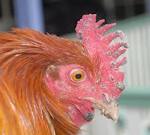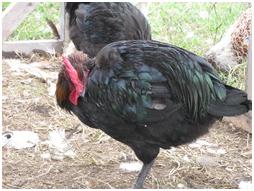Incidences of fowl pox infection are high during rainy seasons
With long and continuous rains as is usual during certain times of the year, there is always a high likelihood of chicken and other poultry catching the fowl pox virus. Birds could get the virus from mosquitoes and other biting insects whose population increase tremendously during such rains. Farmers are therefore warned to look out for signs of this disease at the earliest time possible.
When you observe odd scabs on the comb that gradually darken; and the usually playful birds just standing around with their eyes closed and head under the wings, know that you could be facing a serious disaster, and especially to those farmers with large flocks.
 Fowl pox is a slow-spreading highly contagious viral infection of poultry. The virus attacks the skin, the surface of the mouth and throat leading to the formation of wounds that progress to thick scabs. Mortality is not usually significant unless the respiratory involvement is marked. The disease may occur in any age of bird, at any time. Recovered birds do not remain carriers. Since fowl pox usually spreads slowly, a flock may be affected for several months. The course of the disease in the individual bird takes three to five weeks.
Fowl pox is a slow-spreading highly contagious viral infection of poultry. The virus attacks the skin, the surface of the mouth and throat leading to the formation of wounds that progress to thick scabs. Mortality is not usually significant unless the respiratory involvement is marked. The disease may occur in any age of bird, at any time. Recovered birds do not remain carriers. Since fowl pox usually spreads slowly, a flock may be affected for several months. The course of the disease in the individual bird takes three to five weeks.
Avipoxvirus, the virus that causes this disease is very resistant to drying and can survive in scabs for several years. Different strains of the virus affect different species of birds. Fowl and turkey are prone to the fowl pox virus.
The disease can be spread by direct contact with infected birds, mosquito bites and ingestion or inhalation of contaminated objects. Transmission within a flock is rapid when there are plenty of mosquitoes and is usually observed in relation to seasonal mosquito cycles. Mosquitoes can harbor and transmit the virus for a month or longer through bites after biting an infected bird.
Clinical Symptoms
 The disease can be in two forms, the dry pox (cutaneous form) or wet pox (diphtheritic form) depending on location. The dry form is the most common, affecting the skin and causing wart-like eruptions which in many cases are limited primarily to the feet and legs. The wet form affects the mouth, throat, trachea and lungs causing yellow or white raised and moist necrotic areas that interfere with eating and breathing. Sometimes lesions on eyelids cause closure of one or both eyes.
The disease can be in two forms, the dry pox (cutaneous form) or wet pox (diphtheritic form) depending on location. The dry form is the most common, affecting the skin and causing wart-like eruptions which in many cases are limited primarily to the feet and legs. The wet form affects the mouth, throat, trachea and lungs causing yellow or white raised and moist necrotic areas that interfere with eating and breathing. Sometimes lesions on eyelids cause closure of one or both eyes.
Only a few birds develop lesions at one time and may significantly decrease flock performance. Fleshy pale lumps form yellow pimples that may enlarge and coalesce to form masses of yellow crusts. These scabs darken and fall off in about a week. Bacteria may gain access causing secondary infection resulting in pus and necrosis. Affected areas on the skin completely heal in 2 to 4 weeks if the lesions are not too extensive. The birds become weak, emaciated; show vision problems, difficulty in swallowing and breathing. Others have soiled facial feathers, conjunctivitis, and edema of the eyelids. Laying birds decrease egg production.
Diagnosis
Fowl pox is readily diagnosed on the basis of flock history and presence of typical lesions. In some cases, laboratory diagnosis by tissue or transmission studies is necessary.
Treatment and Prevention
Treatment
There is no specific treatment available. A variety of treatments can be done in severe cases to heal the lesions and prevent secondary infections. This is achieved by removing skin lesions and treating with antiseptics but this may spread the infection to other parts of the skin or to other birds. Usually treatment of this disease is of little value as lesions normally heal within four weeks.
Vaccination
Because ordinary management and sanitation practices will not prevent it, disease control is best achieved by vaccination when less than 20% of the birds have lesions. Several kinds of fowl pox vaccines are available and are effective if used properly.
Two methods of vaccination can be used, i.e. the 'needle stab' or 'stick' method and the follicle method. In the first method, two grooved needles are bound together to make a double-pronged instrument is dipped into the vaccine and thrust through the wing web. In the second method the vaccine is swabbed into feather follicles where sufficient feathers had been plucked from the bird's thigh to expose the skin. Successful vaccination is indicated by small scabs or swollen follicles called "takes," occurring at the inoculation site. Examine vaccinated birds one week later for these takes. Protection becomes effective two to three weeks after vaccination.
Take the following precautions during fowl pox vaccination
- Vaccinate all chickens in a house on the same day
- Only healthy, well nourished birds should be vaccinated.
- Being a live vaccine take precautions to prevent contamination of other parts of the chicken, the premises and the equipment.
- Vaccination of broilers is not usually required unless the mosquito population is high or infections have occurred previously.
- Vaccinate day old chicks by using the wing-web method and using a one needle applicator. Husbandry must be excellent or the chicks may suffer severe reactions.
- Vaccinate all replacement chickens when the birds are six to ten weeks of age.
- One application of fowl pox vaccine results in permanent immunity.
- Vaccinate progeny from recently vaccinated or recently infected flocks only after passive immunity has declined.
- Add antibiotics, glucose and vitamins to the water to keep the birds in good health while fighting the virus.
Control
- Eliminate standing water and all mosquito habitats to control mosquitoes.
- Isolate or cull infected birds to remove the source of the virus.
- Disinfect feeders, waterers, birdbaths and cages with a 10% bleach solution.
